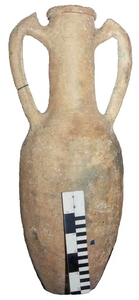Roman Amphorae: a digital resource
University of Southampton, 2005. (updated 2014) https://doi.org/10.5284/1028192. How to cite using this DOI
Data copyright © University of Southampton unless otherwise stated
This work is licensed under the ADS Terms of Use and Access.
Primary contact
Dr
David
Williams
Dept of Archaeology
University of Southampton
Avenue Campus
Highfield
Southampton
SO17 1BJ
England
Tel: 080 593032
Resource identifiers
- ADS Collection: 463
- DOI:https://doi.org/10.5284/1028192
- How to cite using this DOI
Rhodian Type

Courtesy of Dr. Imad Khalil / Graeco-Roman Museum at Alexandria
Imad Khalil
Distinctive FeaturesThis class has a simple rounded rim with cylindrical neck that has similarities to the Dressel 2-4. There are distinctive long single rod handles which rise to a sharp peak, while the body tapers to end in a solid spike, which often has slight corrugations.See characteristics | ||
Date RangeThis form of Rhodian amphora developed from its late Hellenistic prototypes by the late first century BC and is still recorded at Augst up to the mid second century AD (Martin-Kilcher, 1994).Search: [1st century BC] [1st century AD] [2nd century AD] | ||
OriginPetrological analysis suggests several different production centres, all probably located in the Aegean area and in western Asia Minor (Empereur & Picon, 1989; Bezeczky, 2005). Only two fabrics seem to be important, both from the Rhodian Pereia (Peacock, 1977d; Empereur & Tuna, 1989), where kiln sites associated with this form have been found (Empereur & Tuna, 1989; see Peacock, 1997d for details of the other, minor fabrics).Search: [Eastern Mediterranean] [The Aegean] [Western Asia Minor] | ||
DistributionThere is a widespread distribution, from the Aegean, to Cyrenaica, Italy, France, Germany, Pannonia, Switzerland and Britain (Peacock, 1977d; Martin-Kilcher, 1994; Bezeczky, 1994; 2005). The high number of vessels found on military sites from the mid first century AD onwards may be the result of a tribute placed on the Rhodians by Claudius (Peacock, 1977d).Search: [Cyprus] [Eastern Mediterranean] [France] [Germany] [Great Britain] [Greek Islands] [Italy] [North West Europe] [Switzerland] [The Aegean] [The Balkans] | ||
ContentsThis is often considered to be Rhodian wine, but other types of wine may also have been carried (Fraser, 1972: 162-71) and also wine based products (Bezeczky, 2005). Some amphorae of this form on the Dramont D shipwreck of the mid first century AD held figs (Joncheray, 1974: 31-3).Search: [Figs] [Wine] | ||
CommentsPrincipal contributor: David Williams | ||
ClassificationAugst 6Callender 7 Camulodunum 184 Ostia 65 Peacock & Williams 9 | ||



 3D models
3D models


